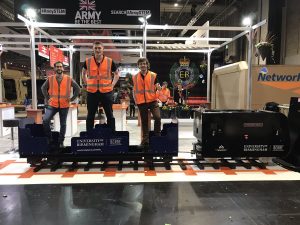 The Big Bang Fair is one of the biggest STEM fairs in the country, attended by vast numbers of young people who come to see the extensive array of demonstrators and exhibitors. This year, along with Network Rail, engineering giants such as Shell, HS2 and Network Rail, as well as all three branches of the armed forces, one of those exhibitions was the UK’s first hydrogen-powered train, Hydrogen Hero. From 13 to 16 March, the team were showcasing the locomotive in one of the cavernous and yet filled-to-the-brim halls at the NEC in Birmingham.
The Big Bang Fair is one of the biggest STEM fairs in the country, attended by vast numbers of young people who come to see the extensive array of demonstrators and exhibitors. This year, along with Network Rail, engineering giants such as Shell, HS2 and Network Rail, as well as all three branches of the armed forces, one of those exhibitions was the UK’s first hydrogen-powered train, Hydrogen Hero. From 13 to 16 March, the team were showcasing the locomotive in one of the cavernous and yet filled-to-the-brim halls at the NEC in Birmingham.
If there is one thing the Big Bang Fair celebrates, it is innovation. Whether that be fuel-efficient cars, water-saving technology or sustainable power, it is new ideas, technologies and techniques that the engineers and citizens of the future will be using. Hydrogen Hero fits this environment perfectly, producing zero harmful emissions at the point of use and yet showing a clear alternative to fossil-fuel power for many UK routes.
Further, this proved an ideal opportunity to explain all kinds of physics, from rolling resistance and electronics through to the “wavy” lines on our brake resistors convecting heat.
This theme of using physics to solve problems in creative ways underpins all engineering and there is certainly no lack of interest in it from the next generation. Indeed, the endless curiosity of children and young people (and their parents!) was on display in every question we were asked.
Outside the locomotive itself, we also spoke about the University and the unique opportunities available to prospective students. Whether that be world-class research or one-of-a-kind degree courses, there was no shortage of interest.
Collaboration is increasingly key to success in engineering, particularly in the case of hydrogen-powered trains and our collaboration with Porterbrook on HydroFlex. Another example was clear at the fair, and thanks must go to Network Rail for allowing us to be part of their stand. This excellent exhibition showcased the wide variety of careers in the rail industry, from the timetable planning and track maintenance to planting and managing trees. Truly, a great example of what can be achieved when we work together.
We would also like to thank all the volunteers who made this possible. Remaining professional and enthusiastic while talking to people of all abilities is not easy, let alone all the setting up and packing away, and our team performed admirably.
Peter Amor, Civil and Engineering Railway Student
